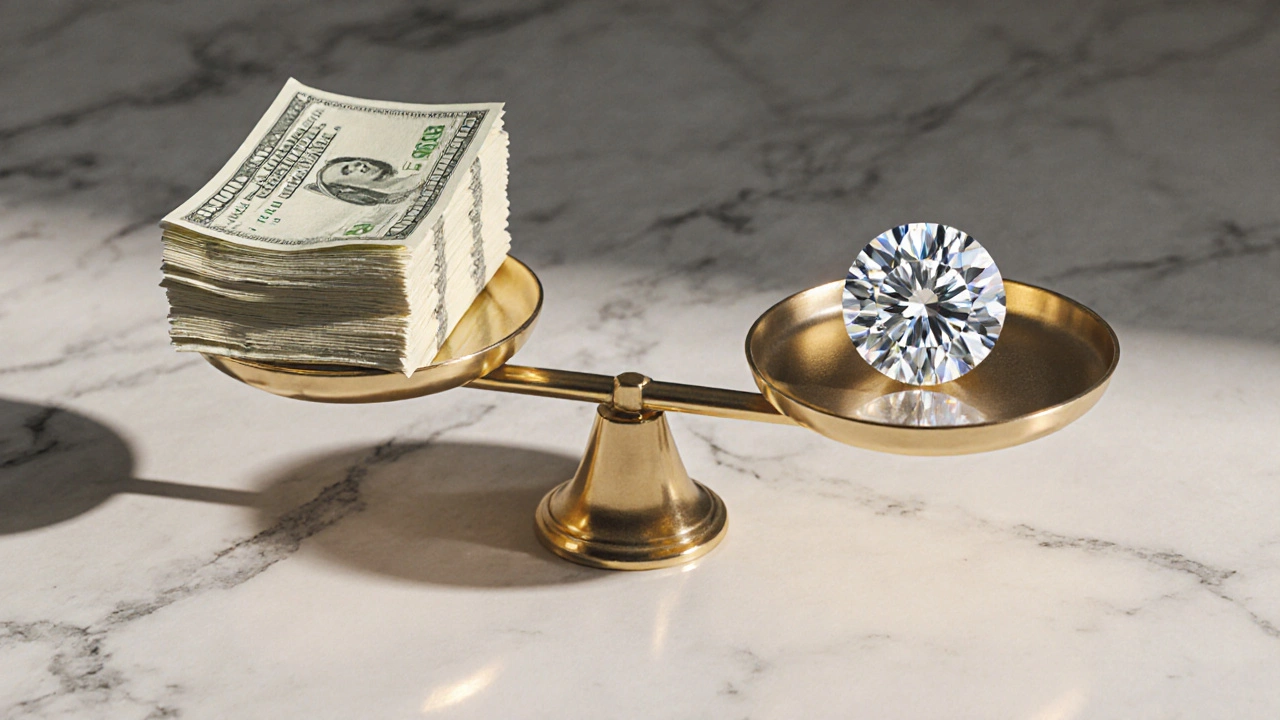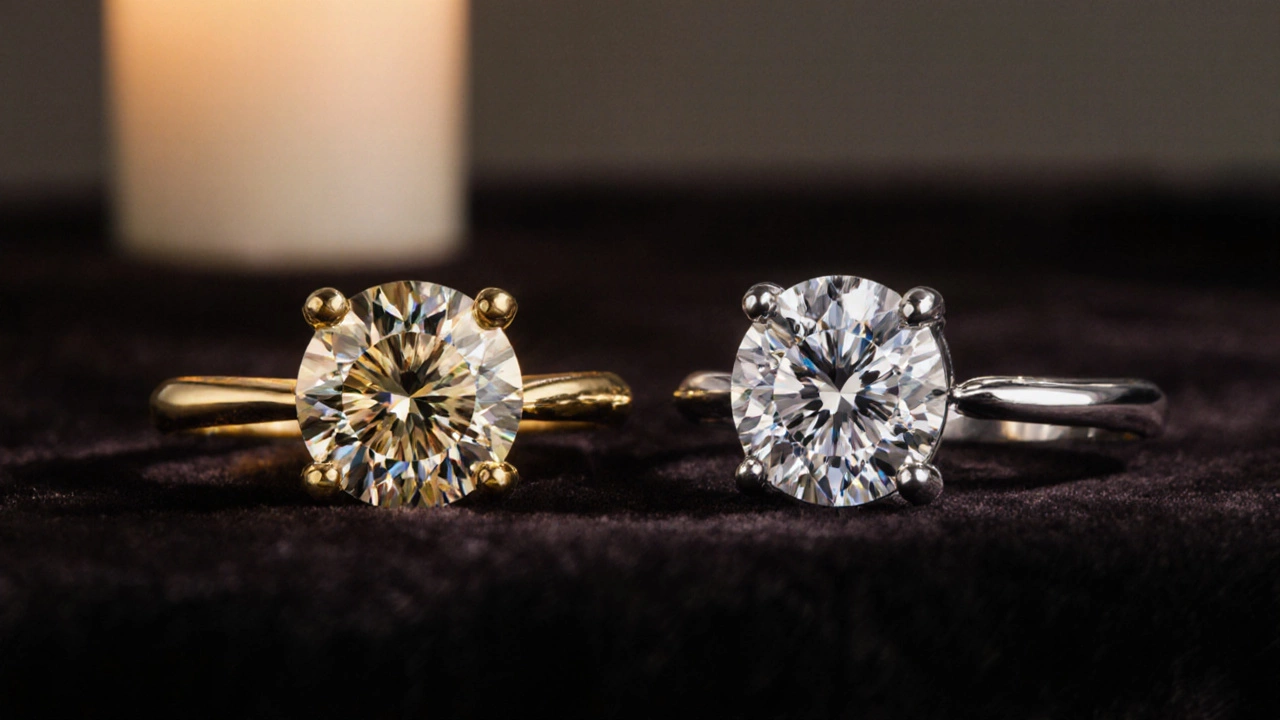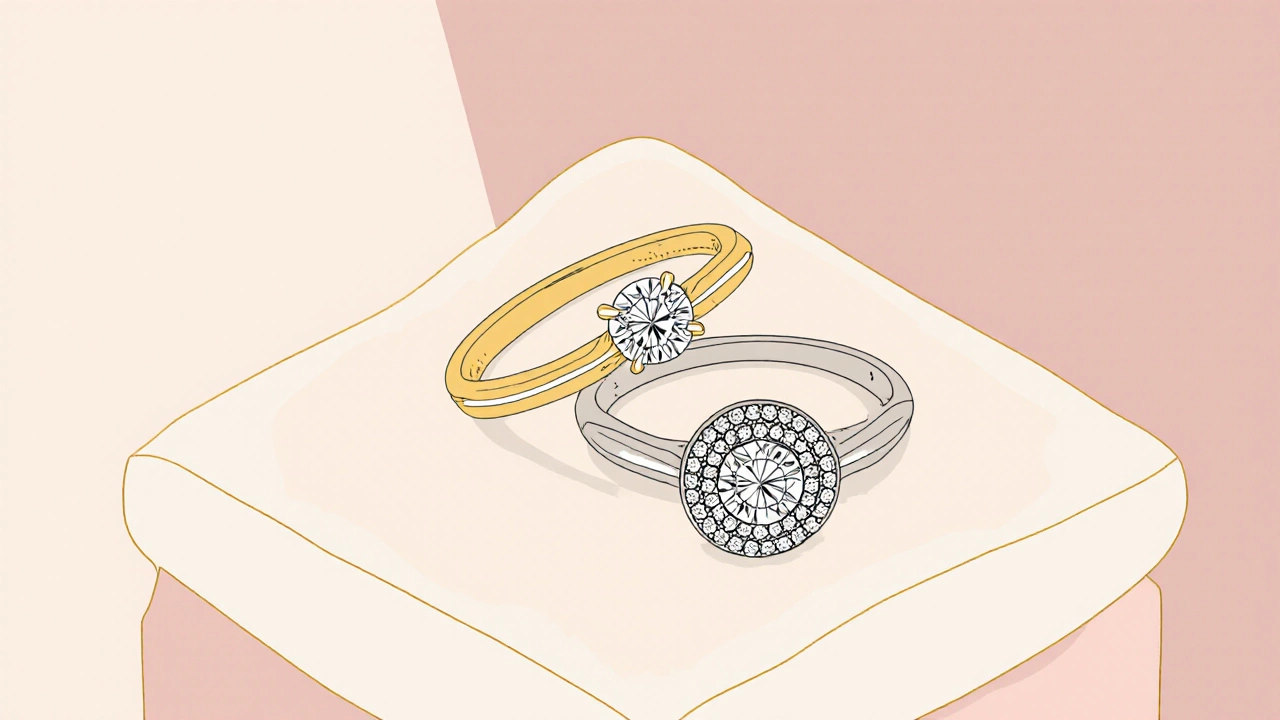How many carats can you get for a $5,000 wedding ring?
 Oct, 21 2025
Oct, 21 2025
Diamond Carat Calculator
Calculate how many carats you can get for your $5,000 budget based on diamond quality and setting preferences.
Your Estimated Carat Value
*Prices based on current market data (2025) for standard round brilliant cuts. Includes setting costs.
Imagine walking down the aisle with a sparkle that feels just right for your budget. You’ve set aside $5,000 for the engagement ring - but how many carats does that actually buy? The answer isn’t a simple number; it depends on the diamond’s quality, the metal you choose, and whether you go natural or lab‑grown. In this guide we break down every factor that turns a dollar amount into a carat count, so you can walk away with confidence.
What does a carat really mean?
When most people hear “carat,” they picture size. In reality, a carat measures weight - exactly 0.2 grams - and is independent of a stone’s dimensions. Two diamonds of the same carat can look very different because of the Cut, the way a diamond is proportioned and polished, its Clarity and the presence of internal or surface blemishes, and its Color grade. Together these make up the famed 4Cs - the industry’s shortcut for evaluating price and beauty.
How far does a $5,000 budget stretch?
To translate a dollar amount into carats you need a baseline price per carat. In 2025 the average market price for a **diamond carat price** sits around $8,000‑$10,000 for a round‑brilliant with good cut, near‑color (G‑H), and VS1‑VS2 clarity. That means a pristine 0.5‑carat stone can easily cost $4,000‑$5,000.
However, most couples don’t buy the highest‑grade stone at the top of the price curve. By compromising on one or more of the 4Cs, you can stretch the budget:
- Cut: Opt for “Very Good” instead of “Excellent.” You’ll lose a fraction of sparkle but save 10‑15%.
- Color: Choose H‑I over D‑E. The visual difference is subtle, especially in a yellow‑gold setting.
- Clarity: VS2 or SI1 looks clean to the naked eye and can shave 15‑20% off the price.
- Carat: Going from 0.50 ct to 0.55 ct adds a noticeable size bump with a relatively small price jump if the other grades stay modest.
Putting those levers together, a $5,000 budget typically yields a natural diamond in the 0.45‑0.55 carat range when purchased as a solitaire.
Metal matters: gold, platinum, and budget impact
The setting metal doesn’t affect carat weight, but it eats into your budget. Platinum is denser and more expensive than gold, often adding $500‑$800 to a ring’s cost. Yellow gold offers the lowest metal cost among popular choices, while White gold sits in the middle, requiring rhodium plating that adds $100‑$200.
If you allocate $600 for a 14K white‑gold setting, the remaining $4,400 can be devoted to the diamond, nudging the carat count up by roughly 0.05 ct.

Natural vs. laboratory‑grown diamonds
Lab‑grown stones have closed the price gap dramatically. In 2025 a lab‑grown round brilliant with the same 4Cs averages $3,500‑$4,500 per carat - about 30‑40% cheaper than its natural counterpart. That means a $5,000 budget can comfortably buy a 0.70‑0.80 carat lab‑grown diamond, delivering a noticeably larger appearance without sacrificing brilliance.
| Diamond Type | Average Price per Carat | Typical Carat for $5,000 | Pros | Cons |
|---|---|---|---|---|
| Natural | $8,500 | 0.55 ct (good cut, H‑I, VS2) | Traditional prestige, resale value | Higher cost, limited carat for budget |
| Lab‑grown | $4,200 | 0.80 ct (Very Good cut, I‑J, SI1) | More carat for same money, eco‑friendly | Perceived lower resale, newer market |
Real‑world $5,000 ring examples
Below are three common configurations you’ll find at reputable jewelers in Melbourne and online retailers.
- Example A - Classic solitaire: 0.48 ct natural diamond (Excellent cut, H color, VS2 clarity) set in 14K yellow gold. Total cost ≈ $4,950.
- Example B - Slightly larger lab‑grown: 0.77 ct lab‑grown diamond (Very Good cut, I color, SI1 clarity) in 14K white gold. Total cost ≈ $4,980.
- Example C - Halo setting boost: 0.38 ct center stone (Very Good cut, G color, VS2 clarity) surrounded by a halo of 0.10 ct diamonds, all in 18K white gold. Total cost ≈ $4,870. The halo adds visual size without increasing the center carat.
Notice how the halo and lab‑grown options give the illusion of a bigger stone without breaking the $5,000 ceiling.

Tips to maximize carat within ,000
- Prioritize cut over color and clarity - a well‑cut diamond looks larger and sparkles more.
- Consider a near‑color grade (H‑J) - the difference is subtle in most lighting.
- Look for VS2-SI1 clarity - inclusions are rarely visible without magnification.
- Choose a lighter metal (14K yellow or rose gold) to free up budget for the stone.
- Explore certified lab‑grown diamonds; GIA, IGI, and EGL all provide reliable reports.
- Ask for a “discounted lab‑grown” or “as‑is” setting - many retailers offer 5‑10% off if you’re flexible on side‑stone quality.
- Shop during sales events (e.g., Melbourne Gem & Jewellery Week) where you can save up to 15%.
By applying these levers you can often land a 0.65‑0.80 ct natural diamond or a 0.90 ct lab‑grown stone without blowing the budget.
Frequently Asked Questions
Can I get a 1‑carat diamond for $5,000?
Only if you compromise heavily on cut, color, and clarity, or if you choose a lab‑grown stone. A 1 ct natural diamond with even modest grades typically starts around $8,000.
Does ring size affect carat price?
No. Ring size only impacts the amount of metal needed. The diamond’s carat weight is independent of band size.
Is a GIA‑certified stone worth the extra cost?
GIA is the most respected grading lab. A GIA certificate adds credibility and resale value, but a reputable IGI or EGL report can also be reliable for a $5,000 purchase.
Should I choose a halo or a solitaire for more sparkle?
A halo surrounds the center stone with smaller diamonds, creating the illusion of a larger wheel of sparkle. It’s a cost‑effective way to look bigger without increasing the center carat.
Are lab‑grown diamonds covered by insurance?
Yes, most insurers treat lab‑grown stones the same as natural diamonds when you provide a proper appraisal.
Armed with these numbers and strategies, you can walk into any jeweler knowing exactly how many carats a $5,000 ring can deliver. Whether you opt for a natural gem or a larger lab‑grown marvel, the right choices will make your engagement sparkle without breaking the bank.